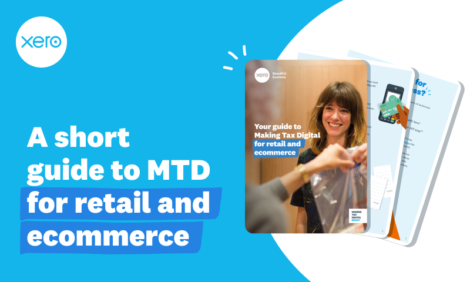
A short guide to Making Tax Digital for retail and ecommerce

Retailers are going through a rapid transformation. New technology, pandemic restrictions, and a digital tax system have been catalysts for change over the past few years.
It’s therefore no surprise that Making Tax Digital (MTD) may feel like yet another big hurdle for your retail or ecommerce business. However, with the right tools and guidance, retailers and ecommerce owners can see MTD as a chance to build a healthier, more sustainable business.
What is MTD for VAT and how will it impact your business?
From April 2022, all VAT-registered retail businesses (including ecommerce retailers and side hustlers) need to follow MTD for VAT rules.
MTD for VAT rules require that you keep digital records and submit VAT returns via MTD-compatible software.
You can also use bridging software, but this has some limitations. For example, with bridging software, you won’t have access to all the helpful retail integrations cloud-based software has to offer. This guide provides more insight into the pros and cons of MTD bridging software for business owners.
What about MTD for ITSA?
If you’re not VAT-registered, you won’t need to follow MTD rules until Making Tax Digital for Income Tax Self Assessment (MTD for ITSA) comes into effect in 2024. MTD for ITSA will impact sole traders (and landlords) with total business or property income above £10,000 per year. You can learn more about MTD for ITSA.
When do I need to comply with MTD?
If you’re a VAT-registered business, you should be complying with MTD rules already.
If you’re not VAT-registered (but are self-employed and/or a landlord) and you earn above £10,000 annually, you will need to follow MTD for ITSA rules from April 2024.
If your total income (from business and/or property) exceeds £10,000, you’ll need to use ITSA-compliant software to keep digital records and send updates to HMRC.
If you earn below the £10,000 threshold, you can continue using the HMRC system to submit your self assessment.
If your business is a general partnership, you won’t need to follow MTD rules until April 2025. However, getting set up early gives you more time to prepare, so start getting ready now if
you can.
Learn more about how to comply with MTD by reading our extensive guide to MTD for the retail and ecommerce industry.
How Xero can help you prepare for MTD
It’s really important to choose MTD software that supports your retail or ecommerce business as a whole, so be sure to carefully check through all of the features included in your MTD software.
The right software should not only make managing your tax obligations easier, but also make it easier to manage your business finances, and simpler to collaborate with your accountant.
Along with helping you to keep, maintain and submit digital records for MTD, Xero can also help you:
- Keep on top of payments
- Manage your cash flow
- Track inventory and stock
- Set up recurring invoices for regular suppliers
- Sync with a wide range of retail and ecommerce apps
You can connect Xero to your card reader, online payment system, and bank account, for automated updates on sales and costs. Learn more about these features, and everything else Xero offers, here.
With packages designed for every stage of your growth, Xero scales with your business. Explore more about why Xero is one of the UK’s most popular ways to submit a MTD VAT return here, or, if you want to learn more about what Making Tax Digital means for you, download our full guide to MTD for retailers and ecommerce business owners.
The post A short guide to Making Tax Digital for retail and ecommerce appeared first on Xero Blog.
Source: Xero Blog






